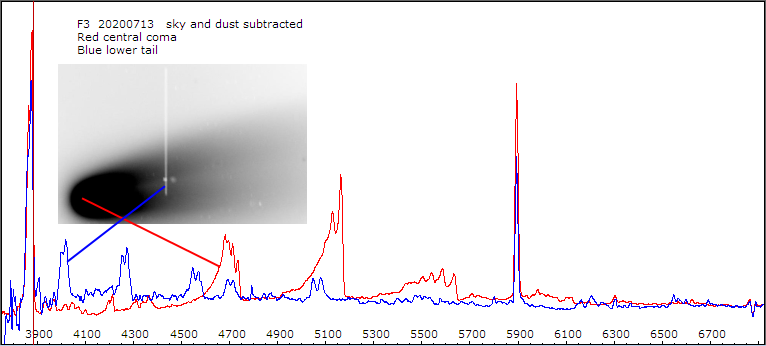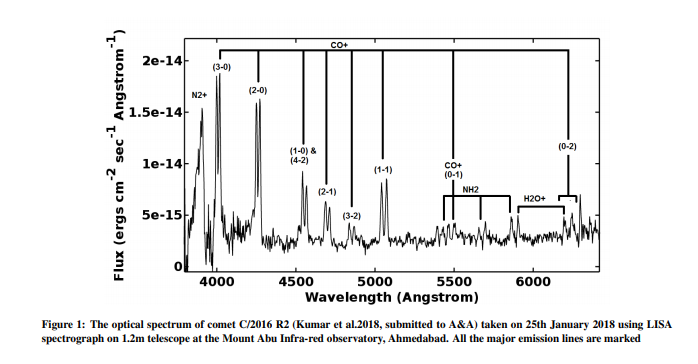Page 1 of 1
F3 spectrum of tail - very strange. Can this be correct ?
Posted: Sun Jul 19, 2020 3:15 pm
by Robin Leadbeater
Hi all,
On 2020-07-13 I took some ALPY600 spectra across the tail of C2020 F3 (NEOWISE). The emission spectrum (sky and dust subtracted) is very different to the coma (except for CN and NaD) with several unidentified doublets and no C2/C3 etc. I did not expect this! Is this correct? (The doublets are clear in the raw images and are only in the comet.) I also have spectra of the other half of the tail and the doublet emission lines are there too. Does anyone know what they are ?

- _c2020f3neowise_nucleus_lowertail_220_30_sky_dust_sub_20200713.png (34.01 KiB) Viewed 7316 times
Thanks
Robin
Re: F3 spectrum of tail - very strange. Can this be correct
Posted: Sun Jul 19, 2020 3:34 pm
by Robin Leadbeater
OK, I have been doing a bit of googling and I think they are from CO+. The ion which gives the ion tail it's blue colour. eg

- COplus_spectrum.png (60 KiB) Viewed 7311 times
from
https://meetingorganizer.copernicus.org ... 8-1220.pdf
If you get the chance the tail is well worth looking at. The intensity is only ~1% of the coma spectrum so you need long exposures but it is completely different from the coma spectrum you usually see
Robin
Re: F3 spectrum of tail - very strange. Can this be correct
Posted: Sun Jul 19, 2020 9:44 pm
by Michel Verlinden
Bonjour Robin,
Bravo pour cette expérience ! Analyser différents spectres générés le long de la fente permet de révèler la présence d'espèces chimiques dans les queues de la comète qu'on ne voit pas nécessairement dans un seul profil, c' est une manip à reconduire tant que C/2020 F3 dégaze beaucoup et reste accessible à nos instruments au sol. Cela sous-entend que les images spectrales 2D de ce type de cible constituent un réservoir de données sous -exploité.
Merci du partage !
Re: F3 spectrum of tail - very strange. Can this be correct
Posted: Sun Jul 19, 2020 10:05 pm
by Michel Verlinden
Robin,
Certaines émissions d'ions sont observées loin du noyau, comme celles de CO+ justement, voir l'article suivant par exemple (page 14):
http://www.astronomie-amateur.fr/Docume ... et2010.pdf
L'expérience que tu as réalisée représente un pas vers une cartographie quantitative de la matière rayonnante, dans la coma et les queues.
Re: F3 spectrum of tail - very strange. Can this be correct
Posted: Sun Jul 19, 2020 11:05 pm
by Robin Leadbeater
Michel Verlinden wrote: Cela sous-entend que les images spectrales 2D de ce type de cible constituent un réservoir de données sous -exploité.
I agree. I was surprised at what we are missing by concentrating on the brightest part of the coma. We need an imaging spectrograph for amateurs! (A drift scan spectrum of the comet would be interesting but there would not be enough time in a night to give enough exposure to see the outer coma and tail)
Cheers
Robin
Re: F3 spectrum of tail - very strange. Can this be correct
Posted: Mon Jul 20, 2020 4:34 am
by Hubert Boussier
Bonjour Robin,
Ces raies doubles ressemblent beaucoup aux raies de la comète C/2016 R2 (PANSTARRS). Très probablement du CO+.
Plusieurs spectres ont été publiés dans la base cometes du LESIA : fin 2017 début 2017
https://lesia.obspm.fr/comets/lib/displ ... ?Num=18651
https://lesia.obspm.fr/comets/lib/displ ... ?Num=18708
https://lesia.obspm.fr/comets/lib/displ ... ?Num=18894
Hubert
Re: F3 spectrum of tail - very strange. Can this be correct
Posted: Mon Jul 20, 2020 11:10 am
by Robin Leadbeater
Hubert Boussier wrote:
Ces raies doubles ressemblent beaucoup aux raies de la comète C/2016 R2 (PANSTARRS). Très probablement du CO+.
Hi Hubert,
Thanks for the links. Yes definitely CO+. It is clear that the spectrum of comets depends strongly on where in the comet they are taken. C/2016 R2 was unusual. The CO+ was seen in the coma.
https://meetingorganizer.copernicus.org ... 8-1220.pdf
In 2020 F3 (and in most comets I think) the CO+ is not seen in the coma, only in the tail (perhaps because the light from dust and C2 etc is normally so bright in the coma)
There are other lines in the tail which are not in the coma in my high resolution spectrum near NaD which I have not yet identified
Cheers
Robin
Re: F3 spectrum of tail - very strange. Can this be correct
Posted: Tue Jul 21, 2020 7:46 am
by Hubert Boussier
An other publication about R2 comet, with radio observations and amateur results from Aras and comissoon des comète of the SAF
http://www.spectro-aras.com/forum/viewt ... =33&t=2165
Hubert